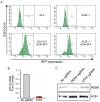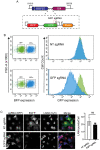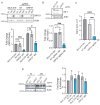CRISPR Interference Efficiently Silences Latent and Lytic Viral Genes in Kaposi's Sarcoma-Associated Herpesvirus-Infected Cells
- PMID: 33924938
- PMCID: PMC8146339
- DOI: 10.3390/v13050783
CRISPR Interference Efficiently Silences Latent and Lytic Viral Genes in Kaposi's Sarcoma-Associated Herpesvirus-Infected Cells
Abstract
Uncovering viral gene functions requires the modulation of gene expression through overexpression or loss-of-function. CRISPR interference (CRISPRi), a modification of the CRISPR-Cas9 gene editing technology, allows specific and efficient transcriptional silencing without genetic ablation. CRISPRi has been used to silence eukaryotic and prokaryotic genes at the single-gene and genome-wide levels. Here, we report the use of CRISPRi to silence latent and lytic viral genes, with an efficiency of ~80-90%, in epithelial and B-cells carrying multiple copies of the Kaposi's sarcoma-associated herpesvirus (KSHV) genome. Our results validate CRISPRi for the analysis of KSHV viral elements, providing a functional genomics tool for studying virus-host interactions.
Keywords: CRISPR-interference; KSHV; Kaposi’s sarcoma-associated herpesvirus; dCas9-KRAB; gene expression; gene silencing.
Conflict of interest statement
The authors declare no conflict of interest.
Figures






Similar articles
-
Reduction of Kaposi's Sarcoma-Associated Herpesvirus Latency Using CRISPR-Cas9 To Edit the Latency-Associated Nuclear Antigen Gene.J Virol. 2019 Mar 21;93(7):e02183-18. doi: 10.1128/JVI.02183-18. Print 2019 Apr 1. J Virol. 2019. PMID: 30651362 Free PMC article.
-
CRISPR/Cas9-Mediated Knockout and In Situ Inversion of the ORF57 Gene from All Copies of the Kaposi's Sarcoma-Associated Herpesvirus Genome in BCBL-1 Cells.J Virol. 2019 Oct 15;93(21):e00628-19. doi: 10.1128/JVI.00628-19. Print 2019 Nov 1. J Virol. 2019. PMID: 31413125 Free PMC article.
-
CRISPR/Cas9 ablating viral microRNA promotes lytic reactivation of Kaposi's sarcoma-associated herpesvirus.Biochem Biophys Res Commun. 2020 Dec 17;533(4):1400-1405. doi: 10.1016/j.bbrc.2020.10.030. Epub 2020 Oct 19. Biochem Biophys Res Commun. 2020. PMID: 33092788 Free PMC article.
-
Potential Application of the CRISPR/Cas9 System against Herpesvirus Infections.Viruses. 2018 May 29;10(6):291. doi: 10.3390/v10060291. Viruses. 2018. PMID: 29844277 Free PMC article. Review.
-
Molecular genetics of Kaposi's sarcoma-associated herpesvirus (human herpesvirus-8) epidemiology and pathogenesis.Microbiol Mol Biol Rev. 2003 Jun;67(2):175-212, table of contents. doi: 10.1128/MMBR.67.2.175-212.2003. Microbiol Mol Biol Rev. 2003. PMID: 12794189 Free PMC article. Review.
Cited by
-
Enhancers and genome conformation provide complex transcriptional control of a herpesviral gene.Mol Syst Biol. 2025 Jan;21(1):30-58. doi: 10.1038/s44320-024-00075-0. Epub 2024 Nov 19. Mol Syst Biol. 2025. PMID: 39562742 Free PMC article.
-
A Two-tiered functional screen identifies herpesviral transcriptional modifiers and their essential domains.PLoS Pathog. 2022 Jan 18;18(1):e1010236. doi: 10.1371/journal.ppat.1010236. eCollection 2022 Jan. PLoS Pathog. 2022. PMID: 35041709 Free PMC article.
-
From enhancers to genome conformation: complex transcriptional control underlies expression of a single herpesviral gene.bioRxiv [Preprint]. 2024 Jun 16:2023.07.08.548212. doi: 10.1101/2023.07.08.548212. bioRxiv. 2024. Update in: Mol Syst Biol. 2025 Jan;21(1):30-58. doi: 10.1038/s44320-024-00075-0. PMID: 37461644 Free PMC article. Updated. Preprint.
-
Applying CRISPR Technologies for the Treatment of Human Herpesvirus Infections: A Scoping Review.Pathogens. 2025 Jul 1;14(7):654. doi: 10.3390/pathogens14070654. Pathogens. 2025. PMID: 40732701 Free PMC article. Review.
-
BiP/GRP78 is a pro-viral factor for diverse dsDNA viruses that promotes the survival and proliferation of cells upon KSHV infection.PLoS Pathog. 2024 Oct 29;20(10):e1012660. doi: 10.1371/journal.ppat.1012660. eCollection 2024 Oct. PLoS Pathog. 2024. PMID: 39471213 Free PMC article.
References
-
- International Agency for Research on Cancer . Globocan 2012: Estimated Cancer Incidence, Mortality and Prevalence Worldwide in 2012. World Health Organisation (WHO); Geneva, Switzerland: 2015.
-
- What Are the Key Statistics about Kaposi Sarcoma? American Cancer Society; Burlington, VT, USA: 2016.
-
- Arias C., Weisburd B., Stern-Ginossar N., Mercier A., Madrid A.S., Bellare P., Holdorf M., Weissman J.S., Ganem D. KSHV 2.0: A Comprehensive Annotation of the Kaposi’s Sarcoma-Associated Herpesvirus Genome Using Next-Generation Sequencing Reveals Novel Genomic and Functional Features. PLoS Pathog. 2014;10:e1003847. doi: 10.1371/journal.ppat.1003847. - DOI - PMC - PubMed
Publication types
MeSH terms
Substances
LinkOut - more resources
Full Text Sources
Other Literature Sources
Research Materials

